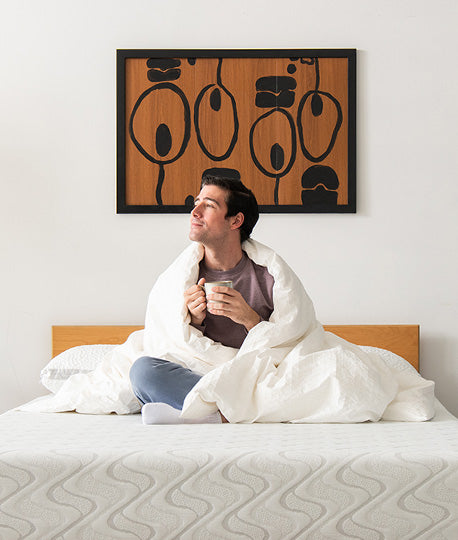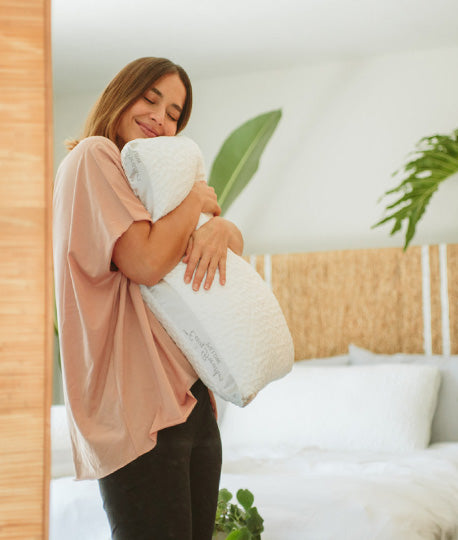How Weighted Blankets Can Give You More Restful Sleep


If you are a sleep-quality aficionado, you may have heard of weighted blankets before. These 15-25 pound blankets are designed to give users a more relaxing, snug-feeling sleep. If you're a light sleeper or low-level stress makes it hard for you to fall asleep in the evenings, this might be just the thing to improve your sleep quality.
What are weighted blankets supposed to do?
For many sleepers, weighted blankets and comforters can reduce or relieve:
- Stress
- Anxiety
- Insomnia
- Tossing and turning
The weight of the blankets is distributed evenly across the entire surface, so the weighted blankets don't feel heavy or smothering. Instead, many users note that the weight comes across as feeling snug, like curling up under a blanket that feels as if the edges are firmly tucked into place under the mattress.
Why does the extra weight help so many sleepers?
According to a growing body of research, added weight creates a feeling of light compression and pressure that relaxes the body. From lightly weighted vests in school to stretching sleeping bags that slightly restrict movement, study after study shows the weight helps children focus and fall asleep. It also applies to adults who frequently find their thoughts wandering at night or who continuously feel the need to shift around.
Weighted blankets introduce a slight physical constraint that helps reduce tossing and turning, too. Despite the added resistance, users can still freely move around. But it takes an extra bit of effort that stops unconscious movements which are responsible for pushing sleep further and further away. Light sleepers that accidentally wake themselves up through small movements also benefit from the added weight: the blanket slows or minimizes the movement, and it's harder to jolt yourself awake.
Many Americans are suffering from insufficient levels of high-quality sleep. There are two parts to this equation:
- Busy schedules and electronics mean many people are merely getting less sleep. People are going to sleep later and later in the evening, but early mornings are still starting at the same time.
- Sleep quality is going down. Those same electronics, mainly because of the blue light, impact users' ability to get deep, restful sleep, even hours after the screen goes black. Abrupt alarms, thin curtains, and frequent noise interruptions all contribute to lighter, less beneficial rest.
While weighted blankets can't do anything about electronics, they can help users get to sleep faster once they curl up in bed. Weighted blankets also slow the body's physical reaction to interruptions. Unless the noise or disruption is sustained, your body will go back to sleep if you don't immediately react.
What are weighted blankets made out of?
Traditional down comforters are made with goose or duck down, which is the softer insulative plumage that traps air. Modern alternatives often use cotton or other insulative fillers instead. When you use a weighted blanket, the inside is with tiny glass or plastic beads.
These pellets let blankets move and shift easily. Good-quality weighted blankets will also have quilt stitches or rows sewn through the layers of fabric to lock the pellets into specific sections. It keeps all of the weight from pooling to one side or misshaping the blanket.
The exterior materials matter just as much as the weighted filler. Most blanket exterior fabrics are designed to do three things:
- Reduce overheating
- Smooth the feel of the interior materials
- Feel comfortable and breathable
Many weighted blankets have a slightly textured inside lining so even sensitive sleepers won't feel the pellets through the blanket, even while they're moving. The fabrics are also carefully selected to allow as much air movement as possible. Different varieties include different levels of insulative power, but many blankets are designed to feel cool, so users don't feel smothered.
What's the right weighted blanket for you?
Before you add a weighted blanket to your shopping cart, create a list of what you want out of any blanket regardless of the weight. Depending on your sleeping preferences, that could include:
- Cotton or organic materials that are right for sensitive skin
- Cooling or breathable fabrics
- Layers for easy washing or so you can switch out the outer duvet layer to best fit the seasons
- Color choices and textures
- Size
Weighted blankets have come a long way since they first became popular in 2017. You can find a weighted blanket that matches all of your specifications, down to the materials. We recommend:
Blankets with separate, machine-washable duvets
Your blanket needs to be washable. So your new blanket stays beneficial instead of turning into an inconvenience, make sure it's easy to wash. A lot of duvets have internal hooks or attachments, so the inner weighted blanket doesn't shift around inside the duvet like a pillow inside of a too-big pillowcase.
Look for stores that sell separate duvet replacements so you always have a backup and you have different textures and thicknesses for different climates throughout the year. Alternatively, layer your weighted blanket with an insulated blank if the extra bulk won't bother you.
Start with a blanket that is 10% of your body weight
The vast majority of scientists and manufacturers agree. If you weigh 150 pounds, start with a 15-pound blanket. That number may seem either too high or too low, but it's a good starting point. A lot of the weight won't be on you. It will be securing the surrounding blanket in place to give you the right level of constraint. It's also just right because you don't want a bunch of weight pinning you in place.
For children:
- Err on the side of lightness. Children need to be able to use and arrange the blankets on their own easily, and that means the blanket has to be something they can pull or tug at easily. If the weight startles them or they feel trapped, they also won't want to use the blanket twice.
- Keep travel constraints in mind. Weighted blankets mean extra weight, and that can be a pain on a flight. If your child adapts to it, that can also mean nights without the blanket on vacations or even naps can be a challenge.
-
Try a few alternatives. Compressing sleeping bags can be just as relaxing without the extra challenges, especially if you have a child with autism or ADHD that sleep better with the pressure.





